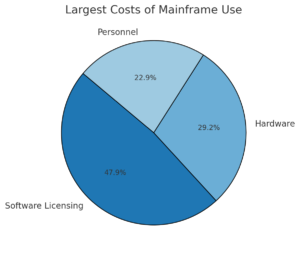Few people doubt the cost-effectiveness of a mainframe production system. But what about the cost of change? In our latest blog, we break down the costs.
Adding it all up
It is widely believed that the IBM Mainframe is the gold standard for high-volume, reliable, mission-critical IT systems. That’s why so many of the leading organizations across various industrial sectors choose to use it.
But its peerless power, performance, and predictability are premium features that carry an equivalent price tag. Owning a native z/OS development environment on System Z hardware can—depending on several factors–easily cost hundreds of thousands to millions annually when factoring in hardware, software licensing, maintenance, infrastructure, and staffing expenses.

These figures are based on assessments by Gartner, as referenced in a report by GTSG Services.
The precise cost of each customer’s mainframe environment varies based on factors such as hardware, software, and staffing mix. Additionally, costs depend on processor power and usage levels—measured in MIPS (Million Instructions Per Second) and MLC (Monthly License Charge).
While the cost per transaction is famously low in a typical mainframe environment (offering more processing per dollar than many alternatives), cost-reduction strategies remain a key focus. Organizations explore optimizing software and hardware usage, performance tuning, and seeking alternative, lower-cost suppliers. This competitive landscape keeps the mainframe market dynamic, proving that even the most robust platforms are subject to cost scrutiny.
Working the cost of change
The real debate centers around the cost of change. Few question the unbridled power and scale of the mainframe as an enterprise server. However, questions remain over the efficiency—and cost-effectiveness—of how mainframe ‘change’ gets delivered.
How efficient are mainframe DevOps workflows?
How agile are the tools and processes supporting mainframe delivery?
Are expensive mainframe LPARs being used for dev and test?
How cost-effective is maintaining ‘always available’ test environments for frequent production changes?
Compromises are usually made, meaning mainframe development can be either efficient or cost-effective – but not always both.
Cost-effectiveness comes in
Several years ago, IBM introduced an off-mainframe, cloud-based z/OS development and testing environment solution that could offer, once up and running, an equivalent environment for mainframe dev teams that would, therefore, reduce (mainframe) hardware and maintenance costs significantly. According to a published price list, IBM Z Development and Test Environment (zD&T) allows emulation of z/OS on x86 hardware starting at $5,980 per user per year. While it would be inappropriate to directly compare this figure, a fully loaded mainframe development LPAR on-premises would likely be considerably more expensive.
Cost Management Pops Up
Helping organizations manage mainframe delivery more efficiently and cost-effectively is a cornerstone of PopUp Mainframe’s mission. Building on IBM’s zD&T concept—and with IBM’s agreement—PopUp Mainframe enhances and automates the process of establishing virtualized mainframe environments for dev and test.
Let’s consider a simple illustration. A mid-to-large mainframe organization with a few hundred developers might easily spend seven figures on dev and test hardware and software costs. Reducing those expenses by two-thirds through virtualization could translate into savings of hundreds of thousands of dollars.
The additional benefit, of course, is that some of that vital MIPS horsepower could be released back to supporting the production systems—the revenue- and value-generating systems that are the heart of the organization.
Summary
For organizations seeking cost-efficient alternatives, emulated or cloud-based solutions like zD&T and IBM’s public cloud offerings provide more affordable options. PopUp Mainframe takes this further by significantly reducing the time required to deploy a virtualized mainframe environment—initiating a PopUp in minutes rather than months.
The quest for efficient, cost-effective mainframe delivery now has a practical solution.
Find out more about PopUp Mainframe Today!

